Holding a piece of history in your hands!
A deck of cards so vibrant and knotty that each piece feels like a miniature masterpiece. This is the world of Ganjifa cards, India’s forgotten treasure of hand-painted playing cards that once dazzled royal courts and spiritual storytellers alike. In this blog, we’ll journey through the rich heritage of Ganjifa’s history, artistry, and cultural legacy. Whether you’re an art enthusiast, a history buff, or simply curious about India’s folk traditions, prepare to delve into a kaleidoscope of colors, myths, and royal games that defined an era.
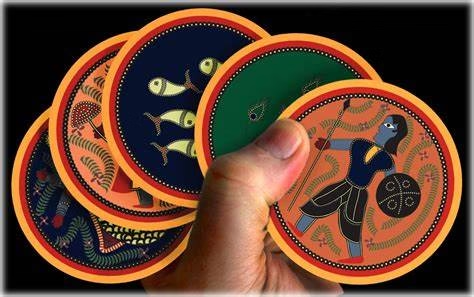
The Origins of Ganjifa – How Persian Treasures Became India’s Royal Playing Cards
From Persian “Ganj” to Mughal-Era Splendor
The word “Ganjifa” traces its roots to the Persian term ganj, meaning “treasure” or “money.” Historians believe these cards arrived in India through trade routes and cultural exchanges with Persia during the 16th century. However, it was under the patronage of the Mughal emperors, particularly Akbar and Shah Jahan, that Ganjifa evolved into a symbol of luxury and intellect. Mughal-era art fused Persian designs with Indian storytelling, creating decks that were not just gaming tools but also canvases for miniature paintings depicting mythology, nature, and elegant life.
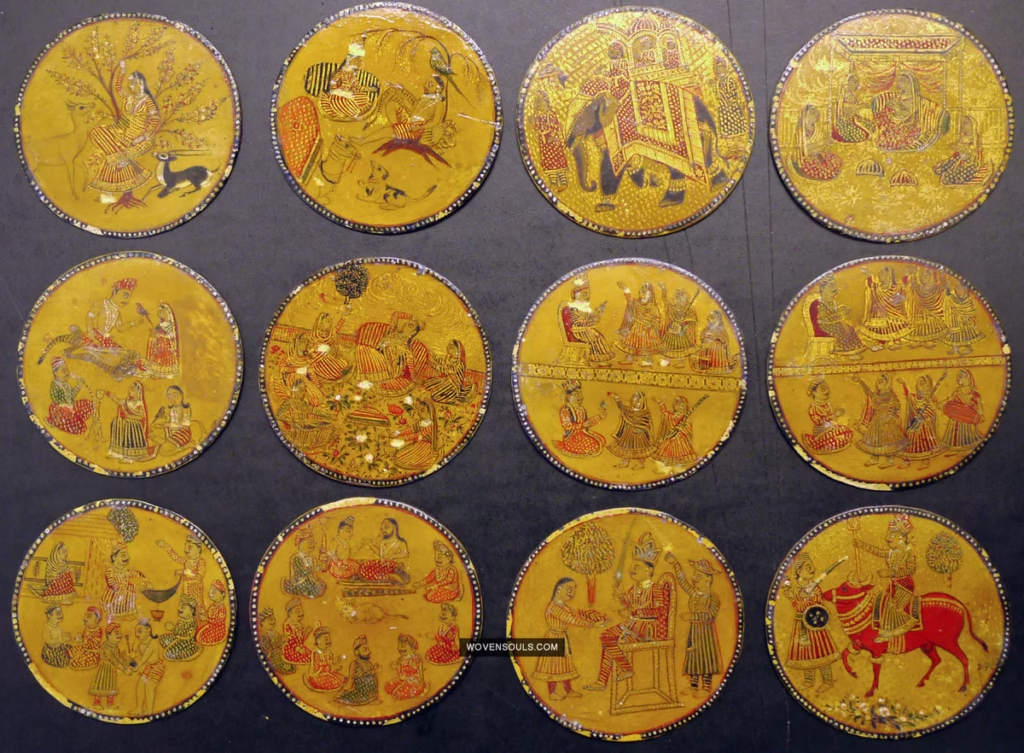
While Persian influence played a key role in shaping Ganjifa, some scholars argue that India had its own early gaming traditions that predate the Mughal era. Ancient texts like the Mahabharata reference dice and board games that hint at a deep-rooted gaming culture. Could there have been a native Indian version of Ganjifa before Persian contact? The answer remains speculative, but it adds an intriguing layer to the game’s history.
Unlike rectangular European playing cards, traditional Ganjifa cards are circular, a design choice that reflects their Persian origins. Crafted from materials like ivory, tortoiseshell, or lacquered wood for royalty and palm leaves or handmade wasli paper for commoners, these cards were a testament to India’s craftsmanship.
Dashavatara Ganjifa – The Spiritual Symbolism Behind India’s Mythological Playing Cards
While Mughal Ganjifa decks often featured abstract designs, the Dashavatara Ganjifa emerged as a distinctly Indian adaptation. Inspired by the ten incarnations of Lord Vishnu (like Matsya the fish and Krishna the divine statesman), these cards became a medium for spiritual education. Each avatar symbolized cosmic balance, teaching players about dharma (duty) and karma (action) through gameplay. This blend of devotion and entertainment made Dashavatara decks popular in temples and households across Odisha, Maharashtra, and Karnataka.
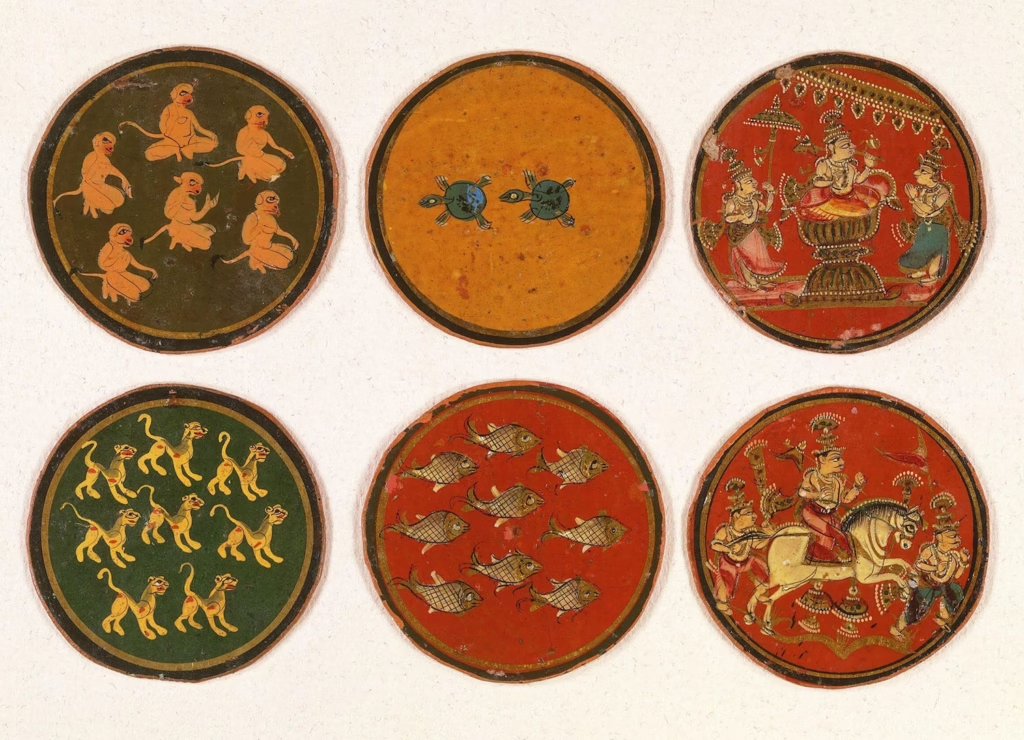
The Craftsmanship of Ganjifa – A Timeless Indian Art Form
How Ganjifa Cards Are Made?
Creating a Ganjifa deck is no ordinary task. Artisans, often belonging to families that have practiced this craft for generations, use miniature painting techniques honed over centuries. The process begins with preparing the base material, layers of handmade paper coated with tamarind seed glue and polished with a stone to create a smooth, ivory-like surface called wasli.
Once the base is ready, the artist sketches out complicated designs with fine charcoal or natural ink. The outlines are then carefully refined before layers of mineral-based pigments are applied, ensuring vibrant yet long-lasting colors. Gold and silver leaf are often added to create a regal touch, especially for decks crafted for royalty. The final step involves sealing the artwork with a protective lacquer coating, ensuring that each card remains as stunning as the day it was painted.
Natural pigments derived from minerals, plants, and even gold leaf are then Scrupulously applied using brushes made from squirrel hair. Each card, typically 2-4 inches in diameter, features complex details – floral borders, delicate facial expressions, and dynamic scenes from epics like the Ramayana. The circular shape not only honors tradition but also challenges the artist’s skill, as compositions must fit harmoniously within the round frame.
Ganjifa Across India – Regional Styles and Unique Traditions
India’s rich cultural heritage is beautifully reflected in its diverse Ganjifa traditions. Let’s embark on a journey to discover the unique styles that have emerged across the subcontinent –
Mysore Ganjifa – The Gold-Leafed Legacy of Karnataka’s Royal Courts
Originating from the royal courts of the Wodeyar kings in Karnataka, Mysore Ganjifa decks are celebrated for their exquisite craftsmanship. Each card is meticulously adorned with gold-leaf embellishments that shimmer with opulence. The designs often draw inspiration from the great Indian epic, the Mahabharata, depicting legendary figures and scenes. Characteristically, these cards are set against vibrant red or deep green backgrounds, colors that symbolize prosperity and spiritual significance, making each play a visual delight.
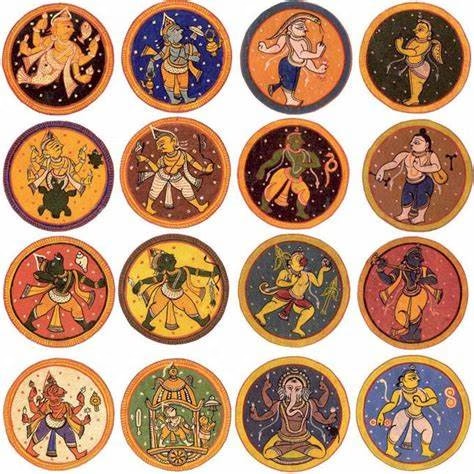
Sawantwadi Ganjifa – Maharashtra’s Hand-Painted Masterpieces
This style, emerging from the picturesque region of Maharashtra, is distinguished by its bold, radiant colors and delicate fish-scale patterns. The Nawabs of Sawantwadi were instrumental in patronizing this artistic form, leading to a fascinating blend of Mughal and Maratha aesthetics. The cards often showcase elaborate designs and vivid hues that capture the eye, making each game not just a pastime but a cultural experience steeped in history.
Odisha Ganjifa – Dashavatara Cards and Their Mythological Connection
Simple yet profound in design, the Ganjifa decks from Odisha emphasize rich symbolism over ornate embellishments. Generally featuring earthy tones, these cards often focus on the Dashavatara, the ten avatars of Lord Vishnu, providing players with a connection to mythology and spirituality. The understated elegance of Odisha Ganjifa reflects the region’s artistic traditions, inviting players to engage with deeper meanings behind each card.
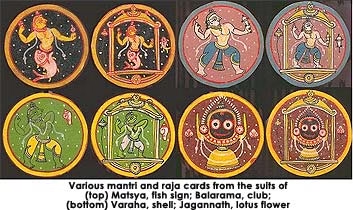
Navagraha Ganjifa – Playing Cards Inspired by Hindu Astrology
A rare and fascinating style, the Navagraha Ganjifa represents the nine celestial bodies in Hindu astrology, each card serving both a recreational and ritualistic purpose. This unique deck not only offers an engaging game but also acts as a spiritual tool, allowing players to connect with the astrological insights of Hindu philosophy. The designs are often elaborate and infused with astrological symbolism, making them a valuable treasure for collectors and enthusiasts alike.
Each of these Ganjifa styles expresses the essence of its respective region, merging artistry, culture, and history into a captivating gameplay experience.
Ganjifa in Royal Courts – A Game of Prestige and Power
A Status Symbol for Nobility
In the wealthy courts of the Mughal and Rajput empires, possessing a Ganjifa deck was not merely a pastime; it was an emblem of prestige and power. Royal figures such as Krishnadevaraya of the Vijayanagara Empire and Raja Sawant Bhonsle of Sawantwadi held extravagant gatherings where the air buzzed with excitement as nobles engaged in spirited games, often wagering precious jewels and vast tracts of land. The cards themselves were masterpieces, meticulously crafted and stored in ornate boxes lined with lush velvet, transforming each game into a grand theatrical event that captivated all who were present.
Storytelling Through Play
Ganjifa was far more than a test of strategic skill; it was a rich narrative experience that blended storytelling with gameplay.
But how exactly was Ganjifa played? A traditional deck consists of 96 or 120 cards, divided into multiple suits. Players would take turns drawing and discarding cards based on matching symbols, numbers, or mythological figures. Some variations involved trick-taking mechanics, while others focused on memory-based challenges. In regions like Odisha, the Dashavatara Ganjifa was used as an educational tool, helping young learners understand Hindu epics through interactive play.
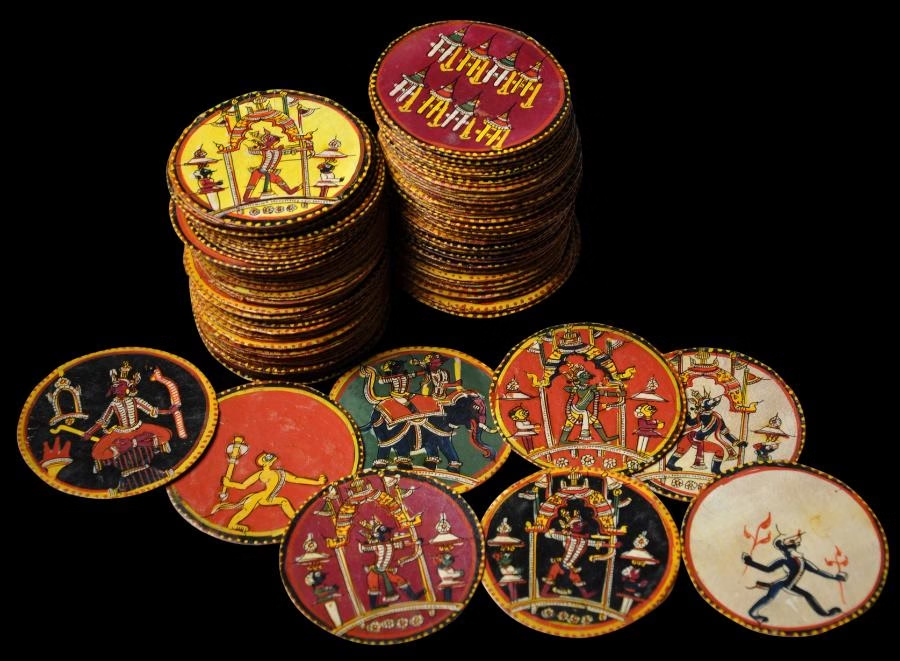
Titles like Naqsh and Krida Patram invited players to immerse themselves in detailed challenges, matching vibrant avatars, solving elaborate riddles, or reenacting epic battles drawn from ancient texts. For instance, in the Dashavatara Ganjifa, players encountered a visually stunning card depicting the Buddha, which held the power to “defeat” the Fish avatar, symbolically illustrating the profound triumph of enlightenment over the tumultuous instincts of the primal self. Each turn offered a new chapter in a living legacy of cultural mythology, captivating players and spectators alike with its depth and complexity.
The Decline and Revival of Ganjifa – From Forgotten Art to Cultural Renaissance
Why Ganjifa Faded into Non-recognition
The once-vibrant art of Ganjifa cards faced a significant decline in the 19th century, largely due to the impacts of British colonialism in India.
But colonial rule was not the only culprit. The rise of mass-produced European playing cards, featuring simpler symbols and standardized rules, made Ganjifa seem outdated. Additionally, the decline of royal patronage and changing social norms meant fewer artisans could sustain themselves by creating these ornate decks. Industrialization brought faster, cheaper entertainment, and Ganjifa gradually disappeared from everyday life.
As European playing cards began to infiltrate Indian markets, they brought with them a wave of affordability and mass production that Ganjifa could not compete against. This influx not only overshadowed the unique cultural significance of Ganjifa but also contributed to the erosion of royal patronage that had traditionally supported the craftsmen behind these elaborate cards. As a result, skilled artisans found themselves struggling to keep their ancient craft alive. By the mid-20th century, only a small handful of families in regions such as Sawantwadi, Mysore, and Odisha remained devoted to preserving this exquisite art form.
Ganjifa Art Revival – Breathing New Life into an Ancient Craft
In contrast to its decline, recent years have witnessed an incredible revival of Ganjifa, fueled by the collective efforts of NGOs, government initiatives, and passionate artists dedicated to rekindling interest in this traditional craft. Modern designers are now exploring Ganjifa-inspired themes in contemporary art, fashion, and digital media. Some have even experimented with augmented reality (AR) and NFTs, creating interactive experiences where users can explore Ganjifa’s mythological worlds in a virtual setting. This fusion of tradition and technology is helping bring the forgotten art to a global audience.
Organizations like the National Institute of Design and the Crafts Council of India have taken an active role in training new artisans, ensuring that the skills and techniques required to create these unique cards are not lost in time.
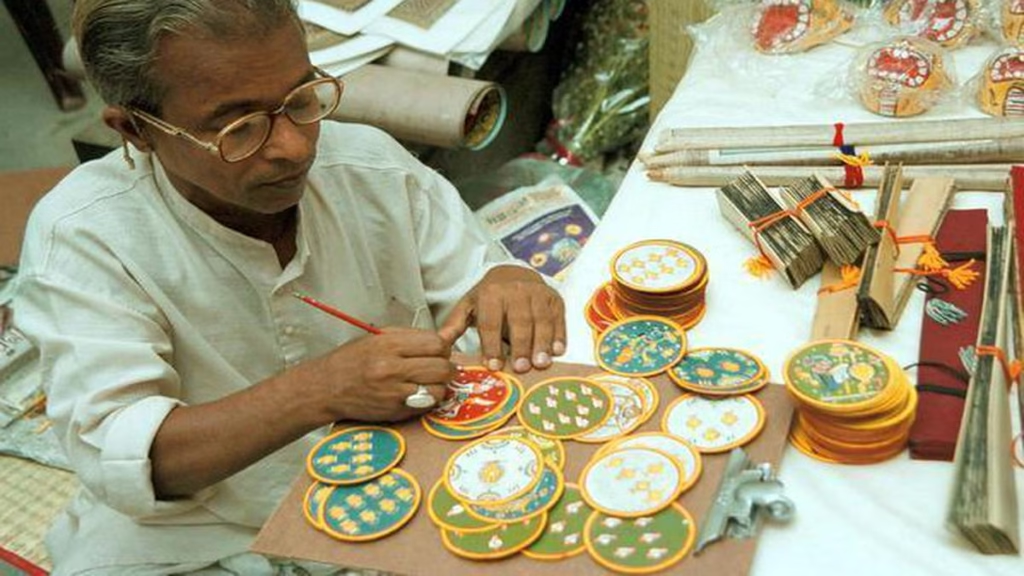
Museums across the country are now hosting engaging exhibitions that present Ganjifa not merely as a tool for gaming, but rather as a form of artistic expression worthy of admiration. The rise of social media has played a pivotal role in this revival, as contemporary artists experiment with Ganjifa designs, incorporating them into modern themes and creating stunning wall art, exquisite jewelry, and even fashionable clothing collections.
In the picturesque town of Sawantwadi, the Raje Crafts Museum offers visitors a unique opportunity to immerse themselves in this rich tradition through hands-on workshops, allowing them to paint their own Ganjifa cards under the guidance of skilled artisans. Meanwhile, Odisha’s Gitagobinda Ganjifa decks, richly inspired by the enchanting hymns of poet Jayadeva, have captured the hearts of collectors from around the globe, drawing them closer to the timeless beauty of this art form. Through these initiatives, Ganjifa is not only being preserved but is also evolving, carving out a contemporary identity while honoring its historical roots.
How You Can Experience Ganjifa Today – Collect, Play, and Preserve
Where to Buy Authentic Hand-Painted Ganjifa Cards
Immerse yourself in the vibrant world of Ganjifa by collecting hand-painted decks crafted by talented artisans in the culturally rich regions of Mysore, Sawantwadi, and Puri. Each deck is a masterpiece, showcasing beautiful designs and vivid colors that reflect traditional Indian art. Websites like Grishya Fashions and Memeraki provide an excellent avenue for purchasing these authentic cards, ensuring that your investment directly benefits the skilled craftsmen who pour their heart and soul into their work.
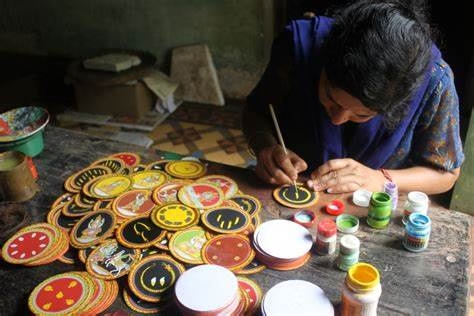
How to Play Ganjifa – A Royal Game Night with Mythology & Strategy
Host an enchanting Ganjifa-themed game night and delve into the fascinating realm of Indian mythology.
Not sure where to start? Look for online tutorials that explain regional variations of Ganjifa games. You can also purchase specially crafted decks from artisan marketplaces and try playing the classic versions or create your own modern twists to the rules!
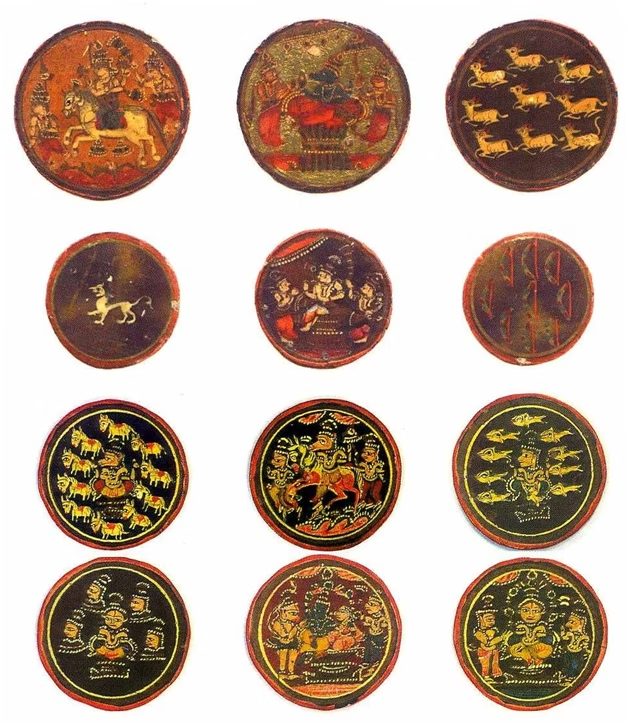
Gather your friends and family to share laughter and stories as you play Dashavatara Ganjifa. With its simple yet engaging rules, players must match various avatars while recounting their heroic tales. This not only brings the ancient game to life but also enriches your knowledge of the rich fabric of Indian culture.
Spread the word by sharing the knowledge
Become an advocate for this remarkable art form by sharing this blog post, following Ganjifa artists on Instagram, or exploring local craft fairs that feature these stunning creations. Every small action you take can have a significant impact on preserving and promoting this UNESCO-recognized intangible cultural heritage, ensuring that future generations can also experience and appreciate the beauty of Ganjifa.
What are Ganjifa cards and why are they special?
Ganjifa cards are traditional hand-painted playing cards from India, known for their circular design, vibrant artwork, and storytelling themes. Unlike regular playing cards, they are crafted with great attention to detail and often depict Hindu mythology, Mughal art, and astrology, making them both a game and a piece of history.
Where did Ganjifa cards come from?
The word “Ganjifa” comes from the Persian word “ganj,” meaning treasure or wealth. These cards were introduced to India through Persian traders and became popular in royal courts during the Mughal and Maratha periods. Over time, Indian artists gave them a local touch by including religious and cultural themes.
How are Ganjifa cards made?
Ganjifa cards are hand-painted on materials like ivory, tortoiseshell, palm leaves, or handmade wasli paper. Artists use natural colors, gold leaf, and fine brushes to create detailed designs. The process takes weeks or even months, as each card is carefully painted by hand.
Can people still play Ganjifa today?
Yes! Though rare, communities in Odisha, Karnataka, and Maharashtra still hold Ganjifa card tournaments, especially during festivals. Artists and historians have also started reviving the game through workshops and exhibitions.
Why did Ganjifa cards lose popularity?
Several reasons led to the decline of Ganjifa, including:
British rule, which brought European playing cards.
Mass production, making modern printed cards cheaper and easier to get.
The end of royal patronage, which once supported artists who made these decks.
Changing lifestyles, with new forms of entertainment replacing traditional games.
Can I learn to paint Ganjifa cards myself?
Yes! Many museums and online workshops teach miniature painting techniques used in Ganjifa. Places like Sawantwadi, Odisha, and Mysore offer sessions where you can paint your own Ganjifa card with expert guidance.
Are Ganjifa cards a good collector’s item?
Yes! Because of their history, craftsmanship, and rarity, Ganjifa cards are highly valued by art collectors, history lovers, and game enthusiasts. Some older decks are even displayed in museums and private collections worldwide.
Conclusion – Keep the Legacy of Ganjifa Alive
Ganjifa cards are not merely artifacts from a bygone era; they are vibrant narratives steeped in tradition, waiting for a new generation to uncover their stories.
Let’s create a future where Ganjifa is no longer just a collector’s item but an everyday cultural touchstone. Schools could incorporate Ganjifa-based storytelling into history lessons, while artists could create new game decks featuring contemporary themes. By embracing this art form in new and exciting ways, we can ensure that Ganjifa continues to thrive for generations to come.
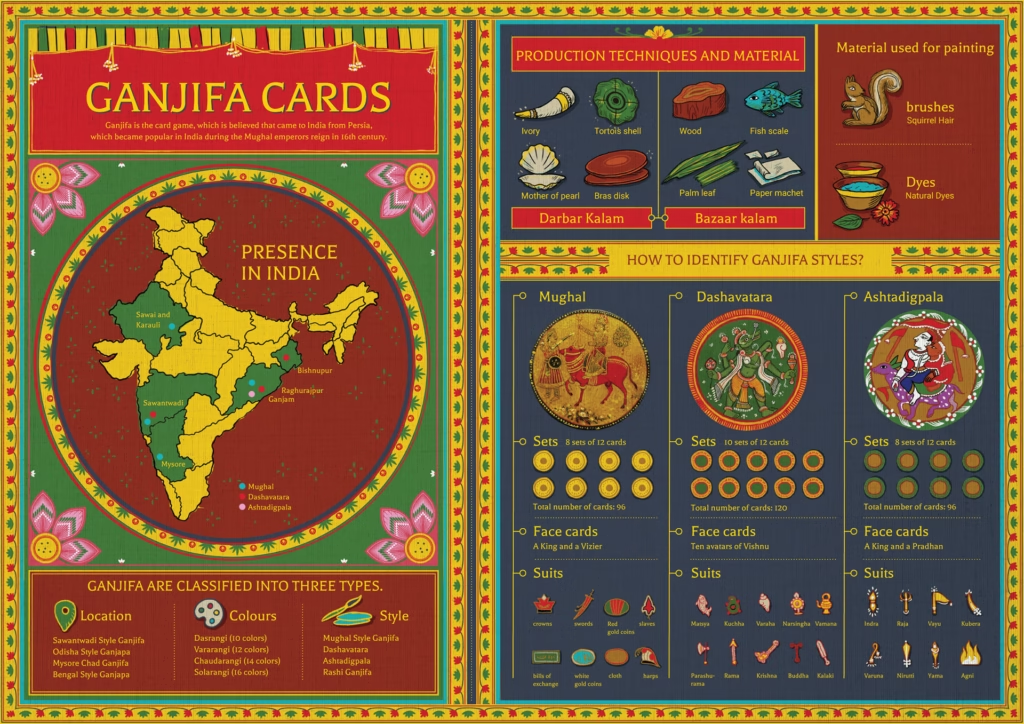
In our rapidly advancing, digital landscape, it is vital to pause and honor the skilled artisans who perpetuate this exquisite craft. Whether you choose to showcase a beautifully designed deck as a work of art, gather with friends for an engaging game, or delve into the rich history behind each card, you become a part of a legacy that has endured across centuries and civilizations.
By intertwining history, art, and practical understanding, you can immerse yourself in the enduring legacy of Ganjifa. Together, let’s honor and celebrate the beauty of India’s cultural treasures!
To explore the vibrant world of art and culture, then visit our FolkCanvas for more exciting content that celebrates the rich world of folk art and creativity.

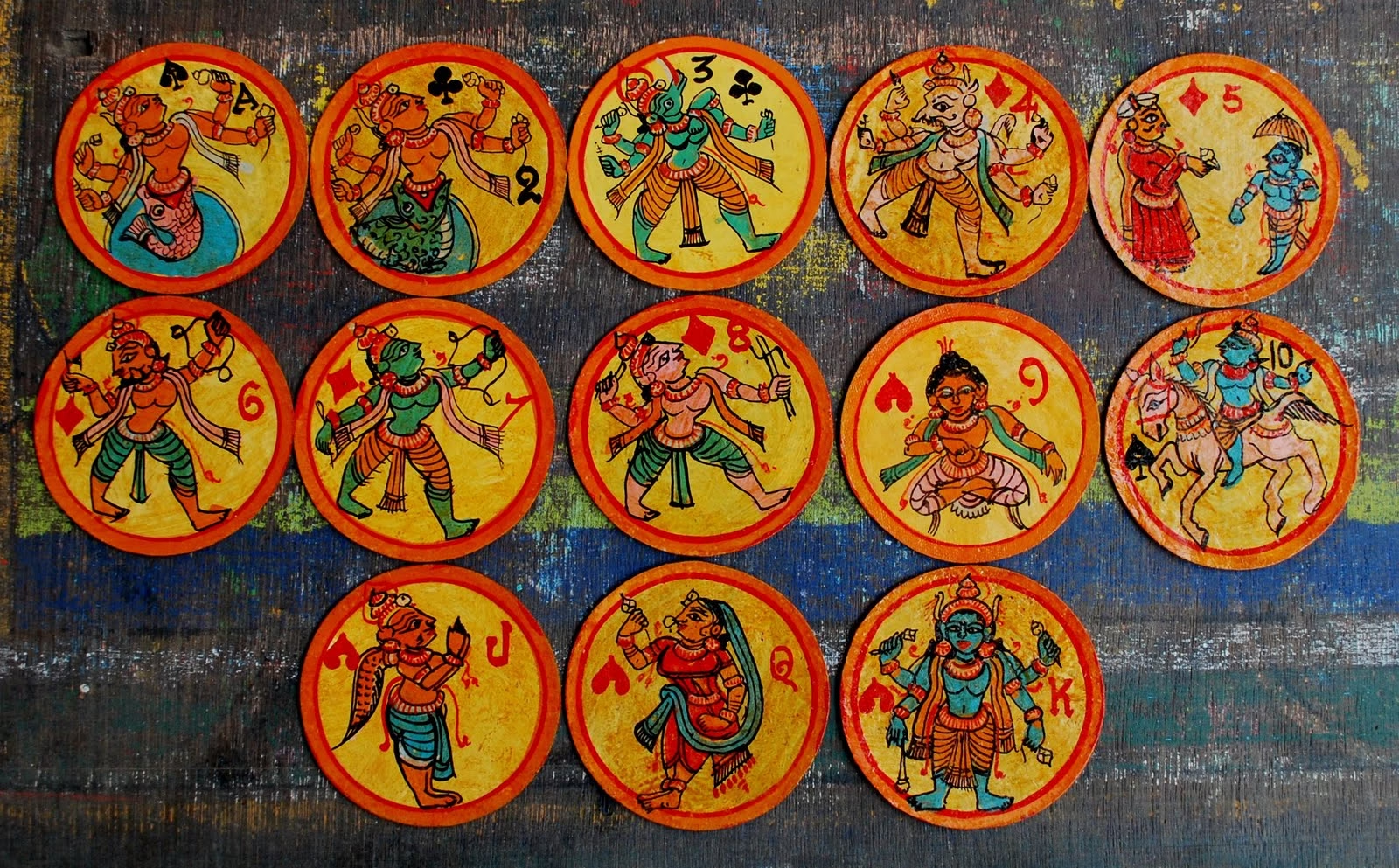

Leave a Reply